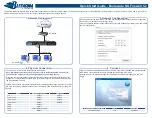
62
Using a Custom Modem Initialization String
A custom Modem Initialization String is sometimes required in order to control the behavior of the modem in
special circumstances. While there are many different initialization string possibilities, the most common one
modifies how the modem handles dial tone. Sometimes the modem may be connected to a circuit that does not
provide the US standard 350/440 Hz dial tone, and in this case, you need to tell the modem to ignore it.
Edit Connection dialog box with “Modem Initialization String” edit box
The extra dialing commands that modify modem behavior should be entered into the “Modem Init:” box in the
Edit Connections menu. If you are “modem init string savvy”, you could ignore the “Modem Init:” box
altogether and place the complete dialing command string into the Phone # box. The choice is yours.
As pointed out earlier, a common customer need is the ability to tell the modem to ignore a non-standard dial
tone. For that situation, the most commonly used options are:
X0 - Disables both busy and dial tone detection.
X1 - Disable busy and dial tone detection.
X2 - Disable busy detection, enable dial tone detection.
X3 - Enable busy detection, disable dial tone detection.
X4 - Busy and dial tone detection enabled.
Given this information, a possible initialization string example configured to ignore the dial tone before dialing,
could be:
ATX0w,xyyyzzzz o
r
ATX0w-,x-yyy-zzz
Where “AT” is the start of the standard modem command string, and;
Where “X0” tells the modem to ignore busy and dial tone detection, and.
Where “x” is the number to dial to reach an outside line (if required), and;
Where “,” is a pause, and;
Where “yyy” is the dialing prefix, and;
Where “zzzz” is the dialing suffix.
There are many resources on the World Wide Web pertaining to the possible Hayes command set initialization
string options. You can locate such resources by using the search text “Hayes Command Set” in your Internet
browser. Two such sites with resources that have been helpful are:
http://www.modemhelp.net/basicatcommand.shtml
http://www.modemexpress.com/
















































